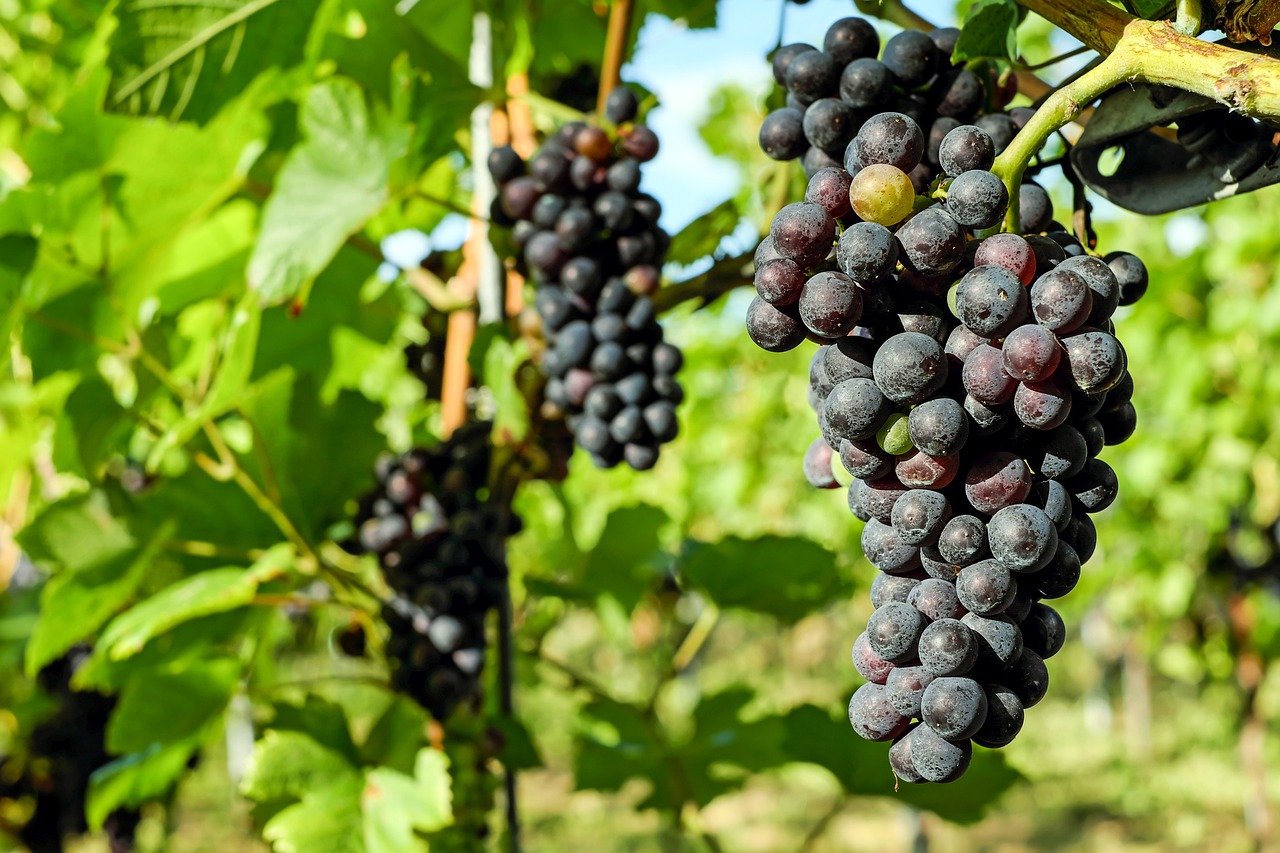I. Understanding Companion Planting for Grapevines
When it comes to cultivating a thriving grapevine garden, it’s not just about tending to the vines themselves.
In fact, the secret to a truly flourishing grapevine garden lies in the art of companion planting.
This age-old practice involves strategically placing certain plants near your grapevines to create a symbiotic relationship that benefits both the grapes and their companions.
Why Companion Plants Matter
Companion planting, especially in the context of grapevine gardens, is far more than just a trendy gardening technique.
It’s a time-tested strategy with numerous benefits for grape growers. Here are a few reasons why companion plants are a must for promoting grapevine health and productivity:
- Pest Control: Certain companion plants act as natural repellents, keeping common grape pests like aphids and nematodes at bay. This means fewer chemical interventions and a healthier grapevine ecosystem.
- Soil Improvement: Many companion plants are soil enhancers. They can improve soil structure, increase nutrient levels, and even fix nitrogen in the soil, providing your grapevines with the ideal growing conditions.
- Biodiversity: A diverse garden is a resilient garden. Companion plants attract a variety of beneficial insects and pollinators, fostering biodiversity and reducing the risk of monoculture-related issues.
- Microclimate Management: Some companion plants provide shade, reduce wind, or act as living mulch, helping to regulate the microclimate around your grapevines. This can be especially valuable in extreme weather conditions.
Exploring the 10 Essential Companion Plants
Now that we’ve established the significance of companion planting in grapevine gardens, let’s take a closer look at the ten essential companion plants that can transform your vineyard into a thriving ecosystem.
These plants have been carefully selected for their ability to complement grapevines and promote their health and well-being.
- Lavender:
- Lavender not only adds a touch of beauty and fragrance to your garden but also attracts beneficial insects like bees and ladybugs, which help pollinate your grapevines and control harmful pests.
- Marigold:
- Marigolds are natural pest repellents, particularly against nematodes. Plant them around your grapevines to deter these soil-dwelling pests and enhance soil health with their root secretions.
- Basil:
- Basil not only serves as a flavorful herb in the kitchen but also acts as a companion plant that repels aphids, whiteflies, and other common grapevine pests. Plus, it can enhance the flavor of nearby grapes.
- Clover:
- Clover is an excellent choice as a cover crop and groundcover in your grapevine garden. It fixes nitrogen in the soil, improving its fertility, and provides a lush, green carpet around your vines.
- Nasturtium:
- Nasturtiums are known for their vibrant flowers and peppery leaves, but they also play a vital role in your grapevine garden by repelling aphids and acting as a trap crop for caterpillars.
- Comfrey:
- Comfrey is a nutrient accumulator and compost activator. Its deep roots draw up nutrients from the soil, making them available to your grapevines, and its leaves are a valuable addition to your compost pile.
- Chives:
- Chives are excellent pest deterrents, particularly against aphids. They also enhance soil health with their root secretions and can be harvested for culinary use.
- Oregano:
- Oregano not only adds flavor to your dishes but also deters grapevine pests like spider mites. It’s a versatile herb that serves both your culinary and gardening needs.
- Sunflowers:
- Sunflowers serve as pollinator magnets, attracting bees and butterflies to your garden. Additionally, they provide shade for your grapevines during hot summer days.
- Thyme:
- Thyme adds aromatic beauty to your grapevine garden and helps deter unwanted insects. Its creeping habit makes it an excellent groundcover option.
As we explore each of these companion plants in more detail in the following sections, you’ll gain a deeper understanding of their unique benefits and how to best integrate them into your grapevine garden.
Whether you’re seeking natural pest control, improved soil quality, or enhanced grape flavor, these companions have got you covered.
II. The Benefits of Companion Plants in Grapevine Gardens
Companion planting is more than just a horticultural trend; it’s a well-established practice with a plethora of benefits, especially when applied to grapevine gardens.
1. Pest Control: A Natural Shield for Your Grapes
One of the most significant advantages of companion planting in grapevine gardens is its natural pest control capabilities.
Many companion plants release chemical compounds or fragrances that repel common grapevine pests.
For instance, marigolds emit a scent that deters nematodes from attacking grapevine roots, reducing the risk of damage to your precious vines.
Similarly, nasturtiums act as a trap crop, luring aphids away from your grapevines and providing a sacrificial alternative for these troublesome insects.
By strategically integrating pest-repellent companion plants into your garden, you can minimize the need for chemical pesticides, thus preserving the health of your grapevines and the environment.
2. Soil Improvement: Nurturing the Vineyard Earth
Companion plants are not just above-ground allies; their root systems play a crucial role in soil improvement.
Some plants, like clover and comfrey, are known as nitrogen-fixing plants. This means they have the ability to absorb atmospheric nitrogen and convert it into a form that grapevines and other plants can readily use.
This natural fertilization process enriches the soil with essential nutrients, promoting healthier vine growth and more robust grape yields.
Additionally, companion plants with deep roots, such as comfrey, help break up compacted soil and improve its structure.
This allows for better water infiltration and root penetration, which is especially vital in regions with heavy clay soils.
3. Biodiversity: A Balanced Ecosystem
Companion planting fosters biodiversity in your grapevine garden, which is essential for a balanced ecosystem.
The diversity of plant species attracts a wide range of beneficial insects, including pollinators like bees and butterflies.
These insects play a pivotal role in grape pollination, ensuring that your vines bear fruit.
Furthermore, a varied plant community discourages the proliferation of grapevine-specific pests.
When grapevines are surrounded by an array of plant species, it becomes more challenging for pests to locate and target their preferred hosts.
This natural form of pest management can reduce the need for chemical interventions and create a healthier and more resilient garden ecosystem.
4. Enhanced Grapevine Health and Yield
Ultimately, the combination of pest control, soil improvement, and biodiversity leads to enhanced grapevine health and increased yield.
Healthy grapevines are better equipped to resist diseases, adverse weather conditions, and stress factors. As a result, you can expect higher-quality grapes and a more bountiful harvest.
Companion planting in grapevine gardens is a holistic approach to vineyard management that leverages the power of nature to nurture your vines.
By harnessing these benefits, you’ll not only enjoy the satisfaction of a thriving grapevine garden but also contribute to a more sustainable and ecologically sound approach to grape growing.
III. Planting and Care Tips
Now that you’re familiar with the essential companion plants for your grapevine garden, it’s time to roll up your sleeves and get your hands in the soil.
Successfully incorporating these companions into your garden requires some strategic planning and care.
1. Companion Plant Selection
- Choose Companions Wisely: Select companion plants based on your specific needs and goals. If pest control is a priority, prioritize plants known for their pest-repellent properties. If soil improvement is needed, opt for nitrogen-fixing companions like clover or comfrey.
2. Placement and Spacing
- Consider Microclimates: Take into account the microclimates within your grapevine garden. Some companion plants may provide shade, which can be beneficial in hot climates, while others may prefer sunnier spots.
- Proper Spacing: Space companion plants appropriately to ensure they don’t compete with your grapevines for resources. Generally, a spacing of one to two feet between companion plants and grapevines is ideal.
3. Soil Preparation
- Prepare the Soil: Before planting your companions, make sure the soil is well-prepared. Remove weeds, rocks, and debris, and amend the soil with organic matter if needed.
4. Planting Companion Plants
- Companion Plant Arrangement: Position companion plants strategically around your grapevines. For instance, you can plant marigolds and nasturtiums at the base of the grapevines to deter pests, while sunflowers can be placed at the perimeter to attract pollinators.
- Planting Depth: Follow the recommended planting depth for each companion plant. Some may need to be planted deeper than others, so read the planting instructions carefully.
5. Maintenance
- Watering: Ensure that companion plants receive adequate water, especially during dry spells. However, be cautious not to overwater, as grapevines generally prefer slightly drier conditions.
- Weeding: Keep the area around your companion plants and grapevines free of weeds, which can compete for nutrients and water.
- Pruning and Deadheading: Regularly prune and deadhead companion plants to encourage healthy growth and prevent them from overshadowing your grapevines.
6. Observational Monitoring
- Pay Attention: Regularly observe your garden to check for signs of pest activity, disease, or nutrient deficiencies in your grapevines and companions. Early detection allows for timely intervention.
7. Adapt and Experiment
- Be Flexible: Gardening is a dynamic process. If you notice that certain companion plants aren’t thriving or aren’t providing the expected benefits, don’t hesitate to make adjustments in the next growing season.
8. Record Keeping
- Maintain Records: Keep a gardening journal to document your planting and maintenance activities. This will help you track what works best in your specific grapevine garden.
By following these planting and care tips, you’ll be well on your way to creating a grapevine garden that not only yields delicious grapes but also thrives as a harmonious and ecologically friendly ecosystem.
Remember that companion planting is both an art and a science, and with patience and experimentation, you’ll discover the perfect companions for your grapevines.
IV. Complementary Design Ideas
Incorporating companion plants into your grapevine garden isn’t just about reaping the benefits of improved grape health and yield—it’s also an opportunity to create a visually appealing and harmonious garden landscape.
1. The Beauty of Biodiversity
- Mix and Match Colors: Choose companion plants with a variety of colors and textures to create a visually dynamic garden. For example, plant vibrant marigolds alongside the lush green of clover or the delicate blooms of lavender.
- Layered Planting: Consider arranging companion plants in tiers or layers around your grapevines. Tall sunflowers in the back can provide a backdrop, while lower-growing herbs like basil and thyme can occupy the foreground.
2. Functional and Aesthetic Edging
- Define Garden Borders: Use companion plants to define the borders of your grapevine garden. Plants like chives or oregano can be strategically planted as edging to delineate garden spaces.
- Herb Spiral: Create an herb spiral with aromatic herbs like basil, oregano, and thyme. This not only adds an eye-catching element but also makes it easier to access fresh herbs for culinary use.
3. Living Mulch and Groundcovers
- Living Mulch: Use low-growing companion plants as living mulch to cover the soil surface between grapevines. This helps conserve moisture, suppress weeds, and contributes to the garden’s aesthetics.
- Stepping Stones: Incorporate flat stones or pavers as stepping stones between companion plants. This not only adds a practical pathway but also adds a touch of charm to your garden.
4. Vertical Interest
- Vertical Gardening: Install trellises or arbor structures for grapevines to climb on. Consider planting climbing companion plants like nasturtiums or flowering vines to add a vertical dimension to your garden.
- Hanging Baskets: Hang baskets of companion plants, such as cascading nasturtiums or trailing herbs like thyme, to create an eye-catching display.
5. Pollinator-Friendly Features
- Butterfly and Bee Gardens: Designate specific areas within your grapevine garden to attract and support pollinators. Plant a variety of nectar-rich flowers to provide food for butterflies and bees.
6. Seasonal Interest
- Year-Round Appeal: Select companion plants that offer interest throughout the seasons. For example, consider incorporating spring-blooming flowers, summer herbs, and fall foliage.
7. Artistic Arrangements
- Create Patterns: Experiment with arranging companion plants in geometric patterns or concentric circles for an artistic touch.
- Themes: Explore themes for your grapevine garden design, such as a Mediterranean herb garden with basil, oregano, and lavender, or a cottage garden featuring a mix of colorful blooms.
8. Sustainable Practices
- Natural Materials: Use natural materials like untreated wood for garden beds, and choose organic mulch options to maintain a more eco-friendly garden.
By implementing these design ideas, you not only make your grapevine garden a visually appealing space but also emphasize the importance of cultivating a harmonious ecosystem.
Your garden becomes a testament to the synergy between plants, showcasing the incredible beauty that nature’s balance can bring to your outdoor space.
Remember that companion planting isn’t just about function; it’s also about form, and with a little creativity, your grapevine garden can be both productive and visually stunning.



